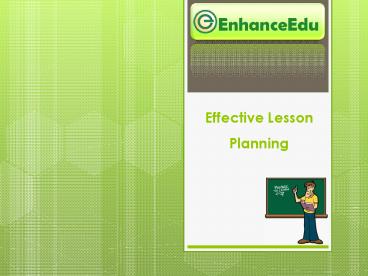Effective Lesson Planning - PowerPoint PPT Presentation
1 / 24
Title: Effective Lesson Planning
1
Effective Lesson Planning
2
Agenda
- Objectives
- Lesson Plan
- Purpose
- Elements of a good lesson plan
- Blooms Taxonomy its relevance
- Presenting the lesson plan
- Reflecting on it
- Common mistakes
- Activity
3
Objectives of this session
- By the end of the session, participants should be
able to - Understand lesson plan design and its elements
- Appreciate the usage of lesson plan in the
classroom - Understand Blooms Taxonomy its application to
classroom - Understand create learning objectives
4
(No Transcript)
5
Lesson Plan
- Purpose
- Elements of a good lesson plan
- Blooms Taxonomy its relevance
- Presenting the lesson plan
- Reflecting on the lesson plan
- Common mistakes
- Activity
6
Purpose
7
Elements of a good lesson plan
- Information about the learners
- Outline learner objectives
- Develop the introduction
- Plan the specific learning activities (the main
body of the lesson) - Assess understanding
- Develop a conclusion and a preview
- Create a realistic timeline
8
- Elements of a lesson plan
- Information about learners
9
- Elements of a lesson plan
- Outline Learner Objectives
- Begin with the end in mind
10
- The mind is not a vessel to be filled, but a
fire to be ignited - Blooms Taxonomy
11
Blooms Taxonomy
- Goals of the educational process
- Three domains of educational activities
- Cognitive
- Affective
- Psychomotor
12
Blooms Taxonomy
Evaluation
Synthesis
Analysis
Application
Comprehension
Knowledge
13
Original Terms
New Terms
Evaluation
Creating
Synthesis
Evaluating
Analysis
Analyzing
Application
Applying
Comprehension
Understanding
Knowledge
Remembering
14
Blooms Taxonomy - Revised
Creating
Evaluating
Analyzing
Applying
Understanding
Remembering
15
- Elements of a lesson plan
- Develop the Introduction
16
- Elements of a lesson plan
- Plan specific learning activities
17
- Elements of a lesson plan
- Assess understanding
18
How?
- Lower Order Questions
- Higher Order Questions
19
- How to apply
- Blooms Taxonomy?
20
Remembering
- Exam Question Cues
- List
- Define
- Tell
- Identify
- Show
- Label
- Collect
- Tabulate
- Quote
- Name
- Who
- When
- Where
21
Remembering
- Exam Question Cues
- List
- Define
- Tell
- Identify
- Show
- Label
- Collect
- Tabulate
- Quote
- Name
- Who
- When
- Where
22
Understanding
- Exam Question Cues
- Summarize
- Describe
- Interpret
- Predict
- Associate
- Distinguish
- Estimate
- Differentiate
- Discuss
- Extend
23
Applying
- Exam Question Cues
- Apply
- Demonstrate
- Calculate
- Complete
- Illustrate
- Show
- Solve
- Examine
- Modify
- Relate
- Change
- Classify
- Experiment
- Discover
24
Analyzing
- Exam Question Cues
- Analyze
- Separate
- Order
- Explain
- Connect
- Classify
- Arrange
- Divide
- Compare
- Select
- Infer
25
Evaluating
- Exam Question Cues
- Assess
- Decide
- Rank
- Grade
- Test
- Measure
- Recommend
- Convince
- Select
- Judge
- Explain
- Discriminate
- Support
- Conclude
- Compare
- Summarize
26
Creating
- Exam Question Cues
- Combine
- Integrate
- Modify
- Rearrange
- Substitute
- Plan
- Create
- Design
- Invent
- What if?
- Compose
- Formulate
- Prepare
- Generalize
- Rewrite
27
- Elements of a lesson plan
- Develop a conclusion
- a preview
28
- Elements of a lesson plan
- Create a realistic timeline
29
Presenting a lesson plan
- Share lesson plan with students
- write brief agenda on the board
- Tell students explicitly what they will be
learning - Provide handout of learning objectives for the
class - Keeps them more engaged and on track
30
Reflecting on a lesson plan
- Lesson plan may not work as expected
- Spend a few minutes after each class
- What worked well and why
- What could have done differently
- Plan for additional feedback
- Helps in adjusting to the contingencies of the
classroom
31
Common mistakes
- Poorly written objectives lead to faulty
inferences - Lesson assessment not connected with behavior
indicated in the objective - Prerequisites not specified or inconsistent with
lesson requirements - The materials specified in the lesson irrelevant
to those described in learning activities - Teachers instructions inefficient
- Students activities do not contribute
effectively to lesson objective
32
Now its your turn
- Create 6 lesson objectives for topic of your
choice - Each objective must involve a different level of
Blooms Taxonomy - You have 15 minutes
- Be prepared to share your objectives with the
group
33
- Thank You

